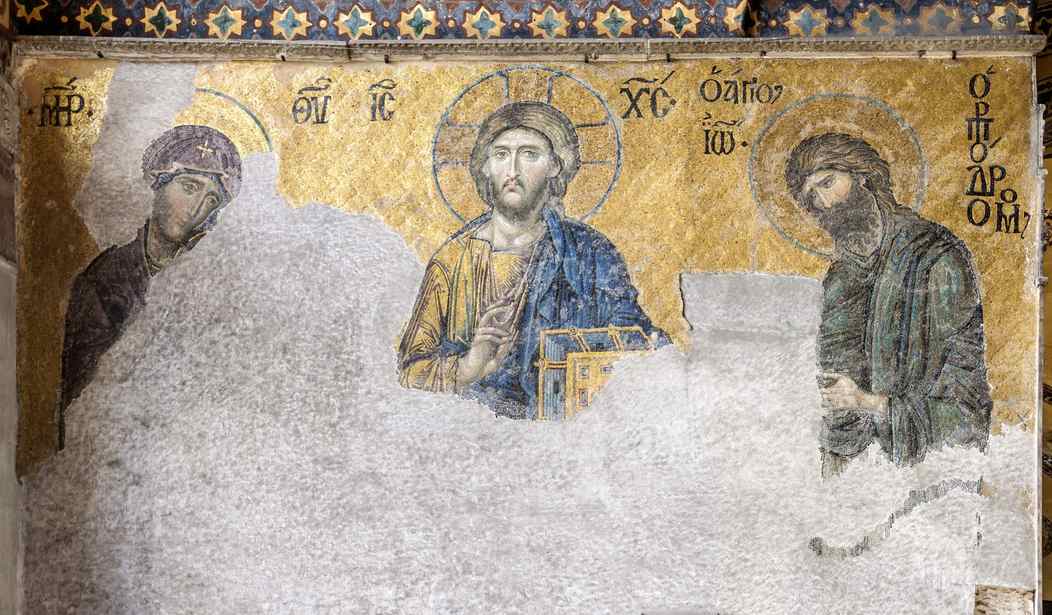When I visited the magnificent Cathedral of Holy Wisdom, or Hagia Sophia, in 2011, I could not help but feel a sense of immense loss. The golden Christian mosaics had been excavated from the walls of the former mosque, but the building retained its thoroughly Islamic character. The magnificent dome featured an ornate carving of an Arabic surah from the Quran. Six massive black discs bearing the names of Allah, Mohammed, and the four Rashidun caliphs dominated the ceiling, and the massive door pointing toward Mecca continued to reorient the room.
Even so, Turkish President Recep Tayyip Erdogan’s order to finally transform the Hagia Sophia into a mosque once more means what little Christian heritage remains in the ornate museum shall be again suppressed and relegated to the dustbin of history. It remains unclear whether or not Erdogan will order the Christian mosaics once again plastered over, as they were following the original transition to a mosque in 1453, but these vestiges of Byzantine civilization will be undermined, one way or another.
On Friday, Turkey’s top administrative court annulled the 1934 presidential decree that transformed the Hagia Sophia from a full-blown mosque to a museum. Mustafa Kemal Ataturk, the great modernizer and secularizer of Turkey, had established the museum as a testament to Anatolia’s Byzantine Christian heritage, as well as its Turkish Islamic heritage.
In 2011, I took a three-week pilgrimage to Turkey with the honors program at my alma mater, Hillsdale College. Every year, the honors program took a trip to Turkey to visit historic sites, including the Hagia Sophia. A few years after our trip, Hillsdale canceled the Turkey trip because Erdogan’s increasing Islamicization of Turkey and the unrest among Turkey’s Kurdish minorities made the country less safe for cultural and historical travel.
Turkey is absolutely gorgeous, especially in May. We traveled by bus from Istanbul to the capital city of Ankara, to the ancient Hittite capital of Hattusa, through Cappadocia, to the ancient Christian Church of St. Peter in Antioch on the Orontes, to the Middle Eastern city of Urfa (which claims to be Abraham’s birthplace), to the mighty Euphrates River, to the Gobekli Tepe temple, to Ararat Mountain, to the crystal-blue waters of Antalya, to the magnificent ruins of the ancient Roman city of Ephesus, to the sites of the cities where St. John the Revelator sent his 7 letters in Revelation, to the multiple levels of ruins at Troy, to the site of the Battle of Gallipoli in World War I, and finally back to Istanbul. It was the trip of a lifetime.
I was quite simply flabbergasted by Anatolia’s riches in history and heritage. The Gobekli Tepe temple is one of the oldest archaeological sites yet discovered, dating back to the 10th-8th millennium B.C. In the second millennium B.C., Anatolia was home to the mighty Hittite empire, which sacked Babylon in roughly 1585 B.C. We strolled the walls along the ruins of the ancient Hittite capital of Hattusa, learning about its sophisticated defenses and marveling at what remained after three and a half millennia.
Before ancient Greece’s Classical Age, Mycenaean Greeks fought many wars on the site of Troy (though the Illiad is a myth, the city is real). During the Roman Empire, Ephesus became a bustling city for trade and culture. The ruins unearthed there put the ruins of the Roman Forum itself to shame. Ephesus was preserved in much of its glory for modern visitors today.
Much of the New Testament consists of letters sent to Christian churches in what was then Anatolia and is today Turkey. Letters to the Galatians, the Ephesians, and the Colossians form books in the canon. Revelation begins with seven letters to seven different cities in Asia Minor, some of which no longer exist, although we strolled along paths where they are believed to have stood.
Long after the mighty Roman Empire fell, the Byzantine Empire persisted in the East, with the magnificent capital of Constantinople. After centuries of Islamic conquest, briefly halted during the First and Second Crusades, the Turks overran that last bastion of Christianity in the East in 1453.
When the Turks arrived, they converted magnificent churches and cathedrals into mosques, plastering over the gorgeous gold mosaics of Byzantium. During our trip, my classmates and I visited one church that had been completely restored to its former Byzantine glory. The entire walls and ceiling were covered with golden mosaics, most of them telling the story of the Virgin Mary and the life of Jesus. One room remained plastered over, so we could see just how empty and barren the Islamic conquerors had made this magnificent cathedral look.
My heart aches to think of all the Christian art still buried beneath the Islamic makeover of the Hagia Sophia. A few magnificent mosaics had been uncovered before my visit, but most of the museum remained distinctly Muslim. One glorious mosaic showed Mary and her infant Son Jesus at the center, with Constantine offering up Constantinople on one side and Justinian offering the Hagia Sophia on the other. This symbol of humility struck with me. While Constantine and Justinian were not the humblest of men, this mosaic portrayed them offering the city and the cathedral to the King of Kings, portrayed in His humble estate as a baby, yet still the King of the Universe.
What treasures remain beneath the Islamic plaster at the Hagia Sophia, never to be uncovered? What will remain of the mosaics I saw in 2011? Will Erdogan’s re-Islamicization of Turkey threaten other cultural sites in Anatolia, the home to so much heritage and culture?
I mourn for the Hagia Sophia, but I also mourn for Turkey itself.
Tyler O’Neil is the author of Making Hate Pay: The Corruption of the Southern Poverty Law Center. Follow him on Twitter at @Tyler2ONeil.









Join the conversation as a VIP Member